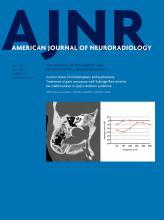Index by author
Gandhi, D.
- NeurointerventionYou have accessManagement of Small Unruptured Intracranial Aneurysms: A Survey of NeuroradiologistsA. Malhotra, X. Wu, B. Geng, D. Hersey, D. Gandhi and P. SanelliAmerican Journal of Neuroradiology May 2018, 39 (5) 875-880; DOI: https://doi.org/10.3174/ajnr.A5631
Gascou, G.
- NeurointerventionYou have accessEndovascular Treatment of Very Large and Giant Intracranial Aneurysms: Comparison between Reconstructive and Deconstructive Techniques—A Meta-AnalysisF. Cagnazzo, D. Mantilla, A. Rouchaud, W. Brinjikji, P.-H. Lefevre, C. Dargazanli, G. Gascou, C. Riquelme, P. Perrini, D. di Carlo, A. Bonafe and V. CostalatAmerican Journal of Neuroradiology May 2018, 39 (5) 852-858; DOI: https://doi.org/10.3174/ajnr.A5591
Gauthier, S.A.
- Adult BrainOpen AccessFast and Robust Unsupervised Identification of MS Lesion Change Using the Statistical Detection of Changes AlgorithmT.D. Nguyen, S. Zhang, A. Gupta, Y. Zhao, S.A. Gauthier and Y. WangAmerican Journal of Neuroradiology May 2018, 39 (5) 830-833; DOI: https://doi.org/10.3174/ajnr.A5594
Geng, B.
- NeurointerventionYou have accessManagement of Small Unruptured Intracranial Aneurysms: A Survey of NeuroradiologistsA. Malhotra, X. Wu, B. Geng, D. Hersey, D. Gandhi and P. SanelliAmerican Journal of Neuroradiology May 2018, 39 (5) 875-880; DOI: https://doi.org/10.3174/ajnr.A5631
Gogoi, B.B.
- Spine Imaging and Spine Image-Guided InterventionsYou have accessThe Importance of Flexion MRI in Hirayama Disease with Special Reference to Laminodural Space MeasurementsD.K. Boruah, A. Prakash, B.B. Gogoi, R.R. Yadav, D.D. Dhingani and B. SarmaAmerican Journal of Neuroradiology May 2018, 39 (5) 974-980; DOI: https://doi.org/10.3174/ajnr.A5577
Gorsage, D.
- FELLOWS' JOURNAL CLUBHead and Neck ImagingYou have accessEvaluation of the Normal Cochlear Second Interscalar Ridge Angle and Depth on 3D T2-Weighted Images: A Tool for the Diagnosis of Scala Communis and Incomplete Partition Type IIT.N. Booth, C. Wick, R. Clarke, J.W. Kutz, M. Medina, D. Gorsage, Y. Xi and B. IsaacsonAmerican Journal of Neuroradiology May 2018, 39 (5) 923-927; DOI: https://doi.org/10.3174/ajnr.A5585
The second interscalar ridge notch angle and depth were measured on MR imaging in normal ears by a single experienced neuroradiologist. The images of normal ears were then randomly mixed with images of ears with incomplete partition II malformation for 2 novice evaluators to measure both the second interscalar ridge notch angle and depth in a blinded manner. For the mixed group, interobserver agreement was calculated, normal and abnormal ear measurements were compared, and receiver operating characteristic curves were generated. The 94 normal ears had a mean second interscalar ridge angle of 80.86° and depth of 0.54mm with the 98th percentile for an angle of 101° and a depth of 0.3 mm. In the mixed group, agreement between the 2 readers was excellent, with significant differences found between normal and incomplete partition type II ears for angle and depth on average. The authors conclude that a measured angle of >114° and a depth of the second interscalar ridge notch of ≤0.31 mm suggest the diagnosis of incomplete partition type II malformation and scalacommunis.
Goyal, M.
- You have accessReply:A.P. Jadhav, B.K. Menon and M. GoyalAmerican Journal of Neuroradiology May 2018, 39 (5) E58; DOI: https://doi.org/10.3174/ajnr.A5617
Griessenauer, C.J.
- EDITOR'S CHOICENeurointerventionOpen AccessEuropean Multicenter Study for the Evaluation of a Dual-Layer Flow-Diverting Stent for Treatment of Wide-Neck Intracranial Aneurysms: The European Flow-Redirection Intraluminal Device StudyM. Killer-Oberpfalzer, N. Kocer, C.J. Griessenauer, H. Janssen, T. Engelhorn, M. Holtmannspötter, J.H. Buhk, T. Finkenzeller, G. Fesl, J. Trenkler, W. Reith, A. Berlis, K. Hausegger, M. Augustin, C. Islak, B. Minnich and M. MöhlenbruchAmerican Journal of Neuroradiology May 2018, 39 (5) 841-847; DOI: https://doi.org/10.3174/ajnr.A5592
Consecutive patients with intracranial aneurysms treated with the FRED between February 2012 and March 2015 were retrospectively reviewed. Complications and adverse events, transient and permanent morbidity, mortality, and occlusion rates were evaluated. A total of 579 aneurysms in 531 patients were treated with the FRED. Seven percent of patients were treated in the acute phase of aneurysm rupture. The median aneurysm size was 7.6 mm and the median neck size 4.5 mm. There was progressive occlusion witnessed with time, with complete occlusion in 18 (20%) aneurysms followed for up to 90 days, 141 (82.5%) for 180 days, 116 (91.3%) for 1 year, and 122 (95.3%) aneurysms followed for more than 1 year. This retrospective study in real-world patients demonstrated the safety and efficacy of the FRED for the treatment of intracranial aneurysms.
Groth, M.
- NeurointerventionYou have accessFactors Influencing Confidence in Diagnostic Ratings and Retreatment Recommendations in Coiled AneurysmsM. Ernst, L. Kriston, M. Groth, A.M. Frölich, J. Fiehler and J.-H. BuhkAmerican Journal of Neuroradiology May 2018, 39 (5) 869-874; DOI: https://doi.org/10.3174/ajnr.A5581
Guimaraes, C.V.
- Pediatric NeuroimagingYou have accessCongenital Aqueductal Stenosis: Findings at Fetal MRI That Accurately Predict a Postnatal DiagnosisK.J. Heaphy-Henault, C.V. Guimaraes, A.R. Mehollin-Ray, C.I. Cassady, W. Zhang, N.K. Desai and M.J. PaldinoAmerican Journal of Neuroradiology May 2018, 39 (5) 942-948; DOI: https://doi.org/10.3174/ajnr.A5590








